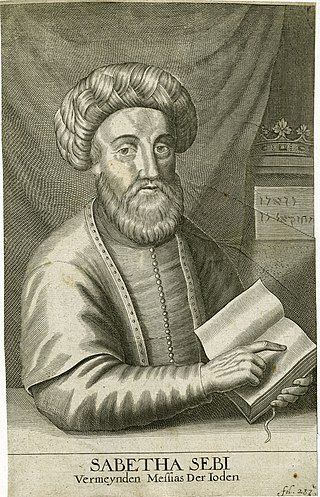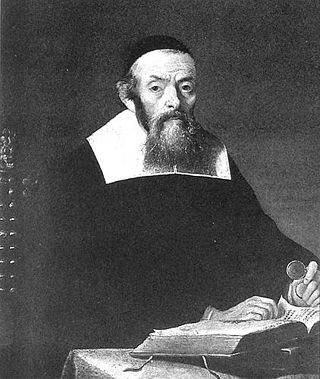Related Research Articles

The Sabbateans were a variety of Jewish followers, disciples, and believers in Sabbatai Zevi (1626–1676), a Sephardic Jewish rabbi and Kabbalist who was proclaimed to be the Jewish Messiah in 1666 by Nathan of Gaza.

Jacob Joseph Frank was a Polish-Jewish religious leader who claimed to be the reincarnation of the self-proclaimed messiah Sabbatai Zevi (1626–1676) and also of the biblical patriarch Jacob. The Jewish authorities in Poland excommunicated Frank and his followers due to his heretical doctrines that included deification of himself as a part of a trinity and other controversial concepts such as neo-Carpocratian "purification through transgression".

Sabbatai Zevi was an Ottoman Jewish mystic, and ordained rabbi from Smyrna. He was likely of Ashkenazi origin. Active throughout the Ottoman Empire, Zevi claimed to be the long-awaited Jewish Messiah and founded the Sabbatean movement.
Mordecai Mokiach was a Jewish Sabbatean prophet and Messiah claimant.

The Dönme were a group of Sabbatean crypto-Jews in the Ottoman Empire who converted outwardly to Islam, but retained their Jewish faith and Kabbalistic beliefs in secret. The movement was centered mainly in Thessaloniki. It originated during and soon after the era of Sabbatai Zevi, a 17th-century Sephardic Jewish Rabbi and Kabbalist who claimed to be the Jewish Messiah and eventually feigned conversion to Islam under threat of death from the Sultan Mehmed IV. After Zevi's forced conversion to Islam, a number of Sabbatean Jews purportedly converted to Islam and became the Dönme. Some Sabbateans lived on into 21st-century Turkey as descendants of the Dönme.

Nathan of Gaza, also Nathan Benjamin ben Elisha Hayyim haLevi Ashkenazi or Ghazzati, was a theologian and author born in Jerusalem. After his marriage in 1663 he moved to Gaza, where he became famous as a prophet for the Jewish messiah claimant Sabbatai Zevi.
Moses Hagiz was a Talmudic scholar, rabbi and writer born in Jerusalem during the time of the Old Yishuv. He was also one of the most prominent and influential Jewish leaders in 17th-century Amsterdam. During Hagiz's lifetime, there was an overall decline in rabbinic authority which was the result of migration and assimilation, and Hagiz devoted his career to restoring rabbinic authority. His most prominent talent was as a polemicist, and he campaigned ceaselessly against Jewish heresy in an attempt to unify the rabbinate.
Abraham Miguel Cardozo was a Sabbatean prophet and physician born in Rio Seco, Spain.
Jacob Hagiz (1620–1674) was a Jewish Talmudist born of a Sephardi Jewish family at Fes, Morocco. Ḥagiz's teacher was David Karigal who afterward became his father-in-law. In about 1646, Ḥagiz went to Italy for the purpose of publishing his books, and remained there until after 1656, supporting himself by teaching. Samuel di Pam, rabbi at Livorno, calls himself a pupil of Ḥagiz. About 1657, Ḥagiz left Livorno for Jerusalem, where the Vega brothers of Livorno had founded a beit midrash for him, and where he became a member of the rabbinical college. There a large number of eager young students gathered about him, among whom were Moses ibn Ḥabib, who became his son-in-law, and Joseph Almosnino, later rabbi of Belgrade. Another son-in-law of his was Moses Ḥayyun, father of Nehemiah Hayyun.
Abraham Yachini was one of the chief agitators in the Sabbatean movement, the son of Pethahiah of Constantinople.

Jacob ben Aaron Sasportas, was a Rabbi, Kabbalist, and anti-Sabbatean. He was the father of Isaac ben Jacob Sasportas.

Frankism was a Sabbatean Jewish religious movement of the 18th and 19th centuries, centered on the leadership of the Jewish Messiah claimant Jacob Frank. Frank rejected religious norms and said that his followers were obligated to transgress as many moral boundaries as possible. At its height it claimed perhaps 50,000 followers, primarily Jews living in Poland, as well as in Central and Eastern Europe.

Solomon Ayllon was Haham of the Sephardic congregations in London and Amsterdam, and a follower of Shabbethai Ẓebi. His name is derived from the town of Ayllon, in what is now the province of Segovia.
Abraham ben Levi Conque, also spelt Konki and Cuenque, was a 17th-century rabbi and kabbalist in Hebron.
Johan Kemper (1670–1716), formerly Moshe ben Aharon Ha-Kohen of Kraków or Moses Aaron, baptized Johann Christian Jacob; was a Polish Sabbatean Jew who converted from Judaism to Lutheran Christianity. His conversion was motivated by his studies in Kabbalah and his disappointment following the failure of a prophecy spread by the Polish Sabbatean prophet Zadok of Grodno, which predicted that Sabbatai Zevi would return in the year 1695/6. It is unclear whether he continued to observe Jewish practices after his conversion.
Abraham Rovigo was a Jewish scholar, rabbi and kabbalist.
Meir bar Hiyya Rofe was a Hebron rabbi, known among other things for his tours of Europe as an emissary from the Holy Land on behalf of the Jewish community of Hebron. His father, Hiyya Rofe, was a very learned rabbi from Safed. Orphaned at a young age, Meir studied in Hebron, leaving about 1648 as an emissary to Italy, Holland, and Germany. On his return journey, he stayed for two years in Italy to publish Ma'aseh Ḥiyya, his father's talmudic novellae and responsa. In Amsterdam he had influenced the wealthy Abraham Pereyra to found a yeshiva in Hebron to be called Hesed le-Avraham, of which Meir himself became the head scholar.
Samuel Primo, was a prominent Sabbatean sectarian of the 17th century.
Rabbi Joseph ben Emanuel Ergas also known as Joseph Ergas was an Italian rabbi and kabbalist, one of the leading critics of Nehemiah Hayyun and Sabbateanism in general.
References
- Grätz, Gesch. 3d ed., x. 190, 204, 225, 229, 312
![]() This article incorporates text from a publication now in the public domain : Singer, Isidore; et al., eds. (1901–1906). "Pinheiro, Moses". The Jewish Encyclopedia . New York: Funk & Wagnalls.
This article incorporates text from a publication now in the public domain : Singer, Isidore; et al., eds. (1901–1906). "Pinheiro, Moses". The Jewish Encyclopedia . New York: Funk & Wagnalls.